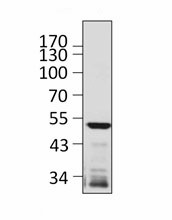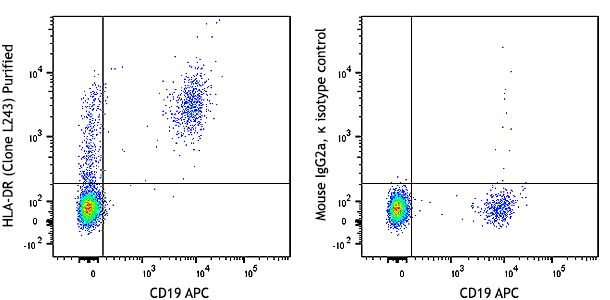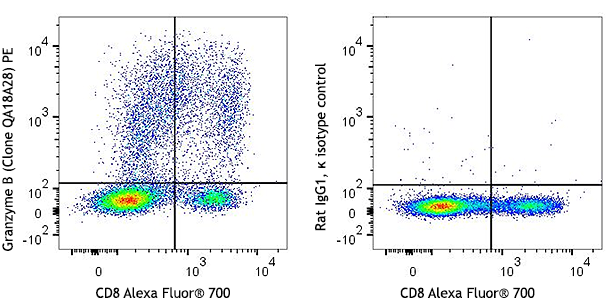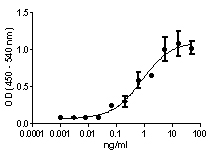- Clone
- 12F9B65 (See other available formats)
- Regulatory Status
- RUO
- Other Names
- Granzyme 2, Cytotoxic T-lymphocyte-associated serine esterase 1, GZMB, CCP1, Asp-ase, Aspase
- Isotype
- Rat IgG2a, κ
- Ave. Rating
- Submit a Review
- Product Citations
- publications

-

5 ng of recombinant, His-thioredoxin tagged mouse Granzyme B was resolved by electrophoresis, transferred to nitrocellulose, and probed with purified monoclonal anti-mouse Granzyme B (clone 12F9B65) antibody. Proteins were visualized using an anti-rat-IgG secondary antibody conjugated to HRP and chemiluminescence detection.
| Cat # | Size | Price | Quantity Check Availability | Save | ||
|---|---|---|---|---|---|---|
| 662801 | 25 µg | $101 | ||||
| 662802 | 100 µg | $300 | ||||
Granzyme B is a serine protease expressed by cytotoxic T cells (CTL) and NK cells. Its main function is to induce cell death to eliminate harmful targets such as allogeneic, virally infected, and tumor cells. This is evident by the fact that CTLs from mice deficient of granzyme B exhibit a profound defect in inducing rapid DNA fragmentation and apoptosis in target cells. Following receptor-mediated conjugate formation between CTL or NK and their target cell, granzyme B enters the target via endocytosis, and subsequently activates multiple protein substrates to induce apoptosis. Most circulating CD56+ and CD8- NK cells, and approximately half of circulating CD8+ T cells, coexpress both granzyme A and B. In contrast, few circulating CD4+ T cells express granzymes A or B. Activation of CD8+ and CD4+ T cells induces substantial expression of granzyme B, but not granzyme A. Besides CTL and NK, evidence has shown that the distribution of human granzyme B has a broader spectrum of cells including CD34+ hematopoietic progenitor cells, keratinocytes, basophils, mast cells, plasmacytoid dendritic cells, and B cells. Although its role in cytotoxic lymphocyte-mediated apoptosis is well established, granzyme B can also degrade extracellular matrix proteins and alter inflammation, if present in the extracellular milieu. These findings suggest that granzyme B can function as an activation molecule with potentially important immunoregulatory functions. In addition, it was shown that expression of granzyme B is elevated in acute coronary syndrome and acute myocardial infarction, indicating that granzyme B could be a factor involved in cardiovascular diseases.
Product DetailsProduct Details
- Verified Reactivity
- Mouse
- Antibody Type
- Monoclonal
- Host Species
- Rat
- Immunogen
- Partial mouse Granzyme B recombinant protein (17-247 aa) expressed in E. coli.
- Formulation
- Phosphate-buffered solution, pH 7.2, containing 0.09% sodium azide.
- Preparation
- The antibody was purified by affinity chromatography.
- Concentration
- 0.5 mg/ml
- Storage & Handling
- The antibody solution should be stored undiluted between 2°C and 8°C.
- Application
-
WB - Quality tested
- Recommended Usage
-
Each lot of this antibody is quality control tested by Western blotting. For Western blotting, the suggested use of this reagent is 0.1 - 0.5 µg per ml. It is recommended that the reagent be titrated for optimal performance for each application.
- Product Citations
-
- RRID
-
AB_2564373 (BioLegend Cat. No. 662801)
AB_2564374 (BioLegend Cat. No. 662802)
Antigen Details
- Structure
- 227 amino acids with predicted molecular weight of 25.3 kD in mature form.
- Distribution
- Secreted.
- Function
- Granzyme B can induce target cell apoptosis by activating caspase independent pathways. It is induced in CD8+ T cells with ConA/ IL-2 and CD4+ T cells with anti CD3/CD28 or CD3/CD46.
- Biology Area
- Cell Biology, Immunology, Innate Immunity, Neuroscience
- Molecular Family
- Proteases, Enzymes and Regulators
- Antigen References
-
1. Edwards KM, et al. 1999. J. Biol. Chem. 274:30468.
2. Grossman WJ, et al. 2004. Blood 104:2840.
3. Heusel JW, et al. 1994. Cell 76:977.
4. Schmid J and Weissmann C. 1987. J. Immunol. 139:250.
5. Trapani JA, et al. 1988. Proc. Natl. Acad. Sci. USA 85:6924.
6. Hiebert PR and Granville DJ. 2012. Trends Mol. Med. 18:732.
7. Saito Y, et al. 2011. J. Cardiol. 57:141. - Gene ID
- 14939 View all products for this Gene ID
- UniProt
- View information about Granzyme B on UniProt.org
Related FAQs
Other Formats
View All Granzyme B Reagents Request Custom Conjugation| Description | Clone | Applications |
|---|---|---|
| Purified anti-Granzyme B | 12F9B65 | WB |
Customers Also Purchased
Compare Data Across All Formats
This data display is provided for general comparisons between formats.
Your actual data may vary due to variations in samples, target cells, instruments and their settings, staining conditions, and other factors.
If you need assistance with selecting the best format contact our expert technical support team.
-
Purified anti-Granzyme B

5 ng of recombinant, His-thioredoxin tagged mouse Granzyme B...
 Login/Register
Login/Register 











Follow Us